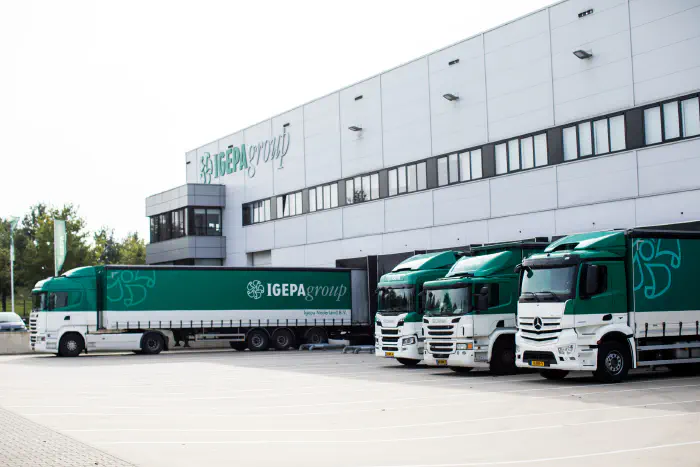

Digital strategy
Content
1. Why you need a digital strategy in 2024
Changing market conditions, a post-pandemic shift in consumer behaviour and rapidly evolving technological advancements in usage of AI and data, are changing the digital landscape we are doing business in. A well-defined digital strategy allows your organisation to leverage the digital opportunities that come with these changes.
In a digital plan opportunities are translated into a strategy and digital initiatives that provide your organisation with a competitive edge. It enables your organisation to scale revenue, increase efficiency and mitigate risks.
1.1 What is a digital strategy plan
A digital strategy is a continuation of your business strategy. In a digital strategy, opportunities are identified, and a plan for the realisation of these opportunities are developed, to accelerate growth of your EBITDA margin and accomplishment of your business strategy.
The digital strategy plan bridges the gap between strategy and execution by defining digital initiatives and their impact on your business results. It gives you;
- Insight in your organisation - a digital plan identifies where your organisation currently stands in terms of risks, productivity and scalability.
- An actionable digital strategy - a roadmap for realisation of digital initiatives with which your organisation can realise opportunities and strengthen itself digitally.
- An operational execution plan - a digital plan bridges the gap between strategy and execution by translating digital initiatives into impact and operational tactics.
1.2 Advancing business objectives with a business-centric approach
Digital strategies are fundamentally business-centric, focusing first and foremost on the company’s objectives and goals. Technology serves as a tool or enabler rather than the driving force. The key principle is that any adoption or investment in technology is guided by how it can advance the business’s objectives—be it improving customer experience, enhancing operational efficiency, or opening new revenue streams.
2. What to expect from a digital strategy plan
A digital strategy plan is not just a roadmap; it’s a transformative blueprint that aligns technology with business goals. It addresses immediate digital challenges but also prepares the company for future technological advancements, ensuring long-term success in an ever-evolving world.
When opting for a digital strategy plan, you are starting a collaborative process in which your business objectives are central, and digital strategy is leveraged as a tool to realise these goals. A digital strategy is developed within a 3-step process, starting with an assessment of the current situation, followed by development of a vision for the future, and concluded with development of a roadmap for prioritisation and execution of digital initiatives.
From initial assessment to strategy formulation and execution, Momentum Digital works as an extension of your organisation. This ensures a strategy that integrates in a seamless way into your company’s fabric.

Elements of a digital strategy
The two main elements of a digital strategy plan are (1) structure -an organisation’s architecture- and (2) an organisation’s way of working -including a customer-centric approach, customer journey mapping, design-driven methodologies, and an iterative process for continuous improvement-.
2.1 Structure: your organisation’s architecture
A digital strategy plan begins with a deep dive into the architecture of your organisation. This is not just about IT infrastructure but about understanding how different components of your business interconnect and how they can be optimised to achieve both your business- and digital goals. This analysis translates into a roadmap towards digital success.
A. Assessing current state and future vision
The first step is to create a common understanding of the current state of your organisation. This involves a thorough analysis of existing business processes, technology, the customer journey and organisational structure. This analysis serves as a foundation for creating a vision for the future, considering the company’s mission, vision, and business goals.
B. Designing a future-ready digital architecture
A future-ready digital architecture involves mapping out the transition from current IT and digital functions to more efficient and integrated systems. Companies might find themselves transitioning through various phases, from having IT as a staff function to fully embedded digital transformation.
C. Aligning technology with business lines
A crucial aspect of structuring is ensuring that technology is not an isolated entity but is embedded within business lines. This means technology choices and investments are directly linked to business outcomes, whether it’s enhancing customer experience, streamlining operations, or unlocking new revenue streams.
X. Translation into a financial forecast
Our approach ensures that a digital strategy is not only aligned with the company’s business objectives but also addresses its core financial challenges. By analysing trends, market conditions, and internal data, we are able to include a financial analysis that is both realistic and strategically valuable.
2.2 Way of working: embracing a customer-centric process
The customer and an organisation’s business processes are at the heart of digital transformation. A digital strategy must include developing an in-depth understanding of both your customer journey and way of working. Visualisation of a customer journey map, implementation of a future-proof way of working and tailoring this to your business objectives will uncover actionable opportunities for improvement.
A. Design-driven development
A design-driven approach enables your organisation to create solutions that are not just technologically sound but also user-friendly and aesthetically appealing. This involves integrating design thinking principles into your organisation, ensuring solutions are created with a user-centric mindset. All tailored to the specific needs of your organisation.
B. A lean approach for continuous improvement
Business processes should be designed in a way that allows for continuous improvement. Adopting such a process involves building minimum viable products and projects, measuring their effectiveness, and learning from the outcomes to make informed enhancements. This loop ensures continuous improvement and adaptability to changing market dynamics.
C. Incorporating an agile organisational culture
An agile culture means being open to change, ready to pivot strategies based on new insights, and fostering a culture that encourages innovation and experimentation. This should reflect in the working culture of your company. Making your employees both a part of your digital strategy, and enthusiastic about your digital transformation.
Conclusion
In conclusion, by focusing on both the structural transformation and the cultural shift towards a customer-centric, design-driven, and lean way of working, businesses can navigate the digital landscape with confidence and clarity to achieve their business goals.
2.3 Questions that are answered within a digital plan
A digital strategy plan is designed to address central questions that are vital for the successful digital transformation of your organisation.
Here are five of these main questions a digital strategy plan will answer:
(1) How can digital tools and technologies help achieve my business objective? This question delves into understanding business goals relevant to your digital transformation. Whether it’s increasing revenue, enhancing customer engagement, improving operational efficiency, or expanding into new markets. The digital strategy plan outlines how digital tools and technologies can be leveraged to meet these objectives.
(2) What digital initiatives should be prioritised for maximum impact? Given the wide array of possible digital initiatives, it’s crucial to identify which ones will offer the most significant benefits. This involves assessing various digital opportunities, from automation and data analytics to customer experience enhancements, and determining which will provide the highest return on investment and align best with your company’s goals.
(3) How will the digital transformation integrate with current business processes? Understanding how new digital initiatives will fit into existing business processes is vital. This includes assessing the need for process re-engineering, the impact on current operations, and how employees’ can play an active role. A digital strategy plan provides a clear roadmap for integration to ensure a smooth transition.
(4) What technologies and resources are required? Your tailored plan addresses the specific technologies, platforms, and infrastructures needed to implement the digital strategy. It also covers the resource allocation – both human and financial – necessary to execute the plan. This includes an evaluation of current technological capabilities and identification of gaps that need to be filled.
(5) How will success be measured and what are the key performance indicators (KPIs)? Defining what success looks like is crucial for any strategy. This involves setting clear, measurable goals and identifying relevant KPIs to track progress. These metrics might include customer acquisition costs, digital conversion rates, process efficiency improvements, or customer satisfaction scores. By answering these questions, a digital strategy plan provides a comprehensive roadmap for businesses to navigate their digital transformation journey, ensuring alignment with business objectives, efficient resource utilization, and measurable outcomes.
3 Achieved results and uncovered opportunities
A digital strategy covers all aspects of your organisation and results in uncovered business opportunities throughout all departments, together creating a synergy that accelerates your digital transformation. Let’s take a look at a few of our success stories and how a digital strategy plan can revitalise different areas of your organisation.
3.1 Areas of improvement
Account management
In account management, a digital strategy facilitates better customer insights and service delivery. Advanced CRM systems can offer a comprehensive view of customer interactions, preferences, and feedback, enabling customer-centric service. Digital platforms also allow for real-time communication and problem-solving, enhancing satisfaction and loyalty.
Pricing strategy
Digital tools enable dynamic pricing strategies, allowing businesses to adjust prices based on market demand, competitor pricing, and customer behavior. Advanced analytics provide insights into the optimal pricing models, maximizing profitability while remaining competitive in the market.
E-commerce
From optimising the user experience on websites to implementing sophisticated inventory management systems, digital strategies ensure seamless online transactions. Integration of AI for personalised recommendations and the use of analytics for understanding consumer behaviour can significantly boost online sales.
Purchasing and logistics
In the realm of purchasing and logistics, a digital strategy helps to streamline operations. Implementing the right ERP and SCM software enhances efficiency. Automation in procurement processes reduces lead times and operational costs. A digital strategy ensures that these aspects are optimised and tailored to your organisation.
Finance
Digital transformation in finance involves automating and optimizing financial operations and reporting. Tools like digital budgeting, forecasting software, and blockchain for secure transactions enhance accuracy and efficiency. Digital strategies also aid in compliance management and risk assessment, leading to more robust financial health.
Marketing and sales
Digital strategies in marketing and sales involve leveraging AI, data analytics, growth marketing, and modern tooling. These strategies and technologies enable effective tactics, automation of tasks, and sales-marketing enablement, leading to increased sales and improved customer retention.
People
The right digital strategy can profoundly impact an organisation’s people aspect. Digital HR solutions, such as automated payroll systems, talent management software, and online training platforms, enhance employee experience and productivity. Combined with the right organisational and cultural approach this can bring your people to new operating heights.
3.2 Examples of success stories
FAQ
Why do I need a digital strategy?
A digital strategy is essential for staying competitive in a rapidly evolving digital landscape. It is vital for integrating and optimizing technology to improve business processes, enhance customer engagement, and achieve business objectives in the current age.
When is the best time to create a digital strategy?
The best time to create a digital strategy is when your organization is planning to achieve its business objectives. A digital strategy plan helps improve business processes, expand market reach, respond to competitive pressure, or realign operations with changing customer expectations and technological advancements.
What are the key elements of a digital strategy?
Key elements of a digital strategy include a clear understanding of business objectives, target audience analysis, technology assessment, data-driven insights, sales and marketing strategies, resource allocation, implementation roadmap, and performance metrics for success evaluation.
What is the difference between a business strategy and a digital strategy?
A business strategy is an overarching plan that guides the overall direction and goals of an organization. A digital strategy is an extension of the broader business strategy, tailored to leverage digital opportunities. It specifically focuses on using modern ways of working, digital tools and technologies, to achieve business objectives.
What makes for a successful execution of a digital plan?
A successful execution starts with clear and impactful use cases that contribute to financial objectives like cost reduction, revenue generation, and risk mitigation. Execution should be collaborative, involving the complete organization for alignment and adaptability. Subsequently, continuous monitoring and a focus on tangible outcomes are key to ensuring that the strategy remains effective and relevant.






